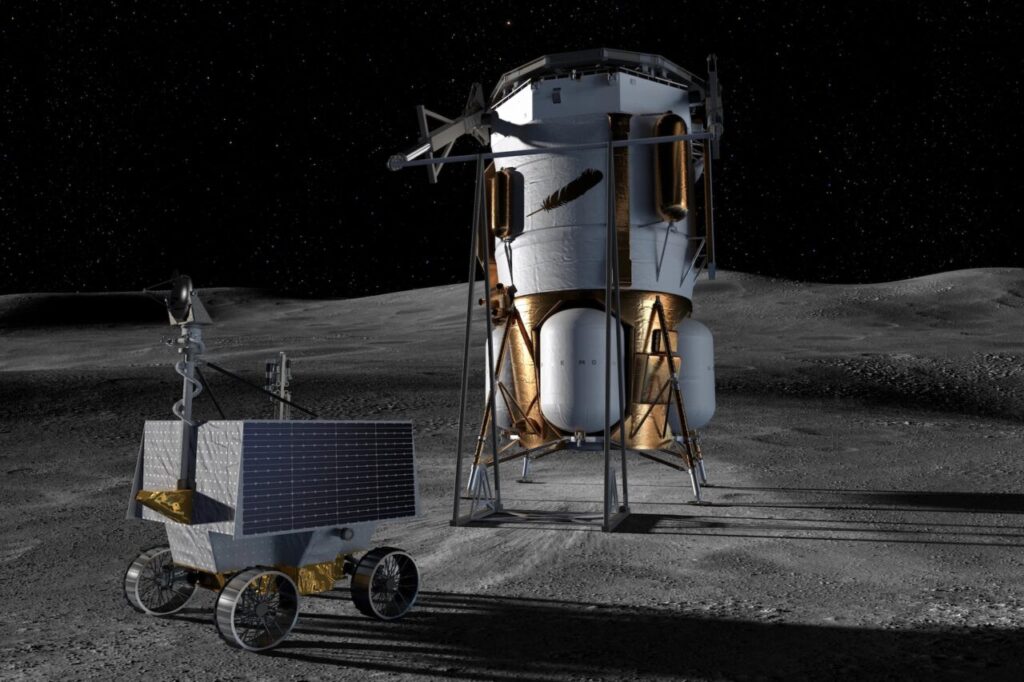
NASA is reevaluating its options for the lunar lander designated for the Artemis 3 mission, with significant delays plaguing SpaceX’s Starship Human Landing System (HLS). As a result, Blue Origin, led by Jeff Bezos, is emerging as a strong contender to provide a timely alternative. Recent updates indicate that Blue Origin’s lunar lander, the Blue Moon Mark 1 (MK1), could potentially launch a demonstration mission before the end of the year.
On Tuesday, Jacqueline Cortese, Blue Origin’s Senior Director of Civil Space, spoke at the American Astronautical Society’s 2025 von Braun Space Exploration Symposium. During her presentation, she outlined the company’s advancements with both the MK1 and a forthcoming MK2 lander. Cortese emphasized that the MK1 is designed to transport up to 3 tons of payload to the Moon’s surface and is seen as a crucial precursor to the more advanced MK2 crew lander.
SpaceX had previously secured a $2.9 billion contract with NASA in 2021 to develop the Artemis program’s first crewed lunar lander. The Starship HLS is expected to land astronauts on the Moon around mid-2027. However, ongoing technical difficulties have raised concerns about whether SpaceX can meet this timeline. The complexities involved in developing the largest and most sophisticated launch vehicle ever constructed have led to multiple delays, with experts warning that Starship HLS could be significantly late.
In a recent interview, acting NASA Administrator Sean Duffy indicated that the agency might open the Artemis 3 contract to other companies, including Blue Origin. Duffy stated, “I’m going to let other space companies compete with SpaceX… whatever one can get us there first, to the Moon, we’re going to take.” This statement appeared to provoke Elon Musk, prompting a series of criticisms directed at Duffy on social media.
Blue Origin’s MK1 lander presents advantages over the Starship HLS, primarily due to its simpler design and proven technology. The MK1 is smaller, with a lower center of gravity, making it easier to land. The development effort is supported by a large team of engineers from Blue Origin, as well as partners like Lockheed Martin, Boeing, Draper, Astrobotic, and Honeybee Robotics.
NASA has already contracted Blue Origin for the MK2 lander, designated for the Artemis 5 mission set to launch in the coming years. Nonetheless, the company is also exploring strategies to accelerate the MK2’s development for Artemis 3. Cortese revealed that the MK1 is currently undergoing final stacking at Blue Origin’s facility in Port Canaveral, Florida. Once this phase is complete, the lander will be transported to NASA’s Johnson Space Center in Houston, Texas, for rigorous testing.
The MK1’s initial demonstration mission, named “Pathfinder,” aims to land near the Moon’s south pole, which will allow Blue Origin to validate critical systems and hardware for the MK2. The mission will also carry two significant NASA payloads: SCALPSS (Stereo Cameras for Lunar-Plume Surface Studies) and LRA (Laser Retroreflective Array). Cortese noted that the MK1’s test flight “would launch in the next couple of weeks,” although she did not provide detailed timing.
If Blue Origin successfully launches the MK1 mission before 2026, it could expedite the MK2 lander’s preparation ahead of its planned Artemis 5 launch, as both landers share much of the same hardware. Nevertheless, the company will need to address several challenges to ensure the MK2 is ready for a crewed mission, including demonstrating propellant transfer and validating the spacecraft’s life-support systems.
Even if selected by NASA for Artemis 3, integrating Blue Origin’s landing system into the existing mission architecture could present unforeseen complications. As it stands, the pressure remains on SpaceX to deliver a functional human landing system by mid-2027. Whether Blue Origin’s advancements will spur a competitive response from Musk’s company is yet to be determined.






